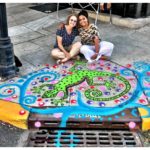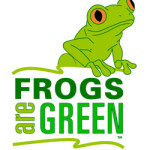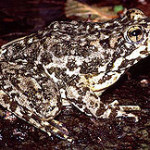Jersey City, have you seen all the colorful images painted on catch basins all around town?
Our city wants residents and business owners to “adopt a catch basin.” When Frogs Are Green heard about this program, in which artists decorate these basins with whatever images you suggest, we claimed a drain, and now the corner of Central Avenue and Bleecker Street boasts a gorgeous, colorful red-eyed tree frog. We also just claimed the opposite corner which we call Biodiversity Matters. Environmental themes make the most sense.
As you walk around Jersey City, you’ll see a lighthouse, fish, turtles, sea turtles, an octopus, and many other original artworks by different artists. When you join the program and adopt a drain, you get to name it and request a certain image.
This is a great way to give artists work, clean up the streets, and show citizens where rain water goes. Once you claim a drain, you become responsible for keeping it clear from trash and, in the colder months, ice and snow. It’s a useful reminder not to throw garbage down there. Year after year I’ve walked around my neighborhood and seen trash and leaves piling up at these catch basins and trees, like a new sign post for trash. Since the city has a limited amount of street cleaners–actual people who only work main streets and only certain days– getting the public involved will help.
About the “Adopt a Catch Basin” program from the Jersey City Office of Innovation’s website:
“Catch basins or sewer drains collect storm and rain water from streets and sidewalks, which then travels into the sewer system. Any debris in the street and on the sidewalk can clog and block a catch basin, causing local flooding and potentially polluting our waterways. Our ‘Adopt a Catch Basin’ program empowers local residents and other volunteers to help keep catch basins clean and expand awareness of our sewer system.”
Once I made this commitment, I started researching what does go down the drain besides rain water and have discovered some unbelievable facts.
NJ’s sewage systems are old and in serious need of repair. Just read this article about what happened to the Middlesex County Utilities Authority in New Jersey. They were just starting to repair the main pump when Hurricane Sandy hit.
…Hurricane Sandy triggered flooding that knocked out the Passaic Valley Utility Authority in Newark—the fifth-largest wastewater treatment facility in the country—for weeks, sending some 840 million gallons of untreated sewage into Newark Bay, according to a 2013 report by the independent research organization Climate Central.
The federal EPA in 2008 estimated the cost of upgrading New Jersey’s CSOs statewide at $9.3 billion.
…Environmentalists warn that the high cost of fixing New Jersey’s ailing sewer systems pales beside the cost of doing nothing. While our ocean waters were deemed swimmable in a July 2013 DEP assessment, 73 percent of the state’s non-ocean waters tested failed due to bacteria indicating the presence of fecal matter. And only 3 percent of 952 watersheds were judged safe to eat, with 38 percent containing dangerous levels of mercury or toxic PCBs…
Please read the entire article here:
https://njmonthly.com/articles/jersey-living/down-the-drain-njs-sewage-system/
Just imagine what this means to wildlife. Let’s all do our part in helping the environment be safe for all.





